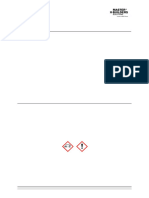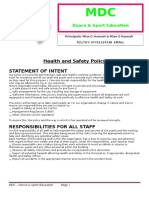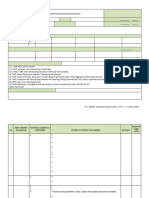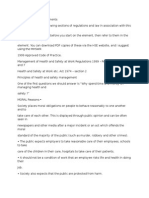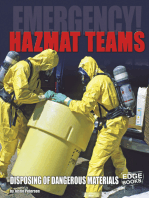Abamectin MSDS
Abamectin MSDS
Uploaded by
Žarko MilutinovićCopyright:
Available Formats
Abamectin MSDS
Abamectin MSDS
Uploaded by
Žarko MilutinovićOriginal Description:
Original Title
Copyright
Available Formats
Share this document
Did you find this document useful?
Is this content inappropriate?
Copyright:
Available Formats
Abamectin MSDS
Abamectin MSDS
Uploaded by
Žarko MilutinovićCopyright:
Available Formats
MATERIAL SAFETY DATA SHEET
eChem (Australia) Pty Ltd
Level 4, Lantos Place
80 Stamford Road, Indooroopilly QLD 4068
Ph: 1300 781 649 Fax: 1300 781 650
A.C.N. 089 133 095
SECTION 1
Page 1 of 6
Issued: March 2013
Emergency Contact:
1800 033 111
IDENTIFICATION OF THE MATERIAL AND SUPPLIER
Product Name:
eChem Abamectin Insecticide/Miticide
Full Product Name:
Other Names:
Use:
eChem Abamectin Insecticide/Miticide.
Abamectin.
Liquid insecticide/miticide for use on cotton and the control of pest
mites on pears, apples, tomatoes, strawberries and ornamentals.
eChem (Australia) Pty Ltd
Company:
Address:
ACN/ABN:
Telephone Number:
Emergency Contact:
SECTION 2
Level 4, Lantos Place 80 Stamford Road, Indooroopilly QLD 4068
089 133 095
02 6750 8019
1800 033 111
Fax Number: 02 6752 3123
HAZARDS IDENTIFICATION
Classified as hazardous according to criteria of Safe Work Australia.
Classified as a Dangerous Good according to the ADG Code.
Combustible Liquid (C1).
Risk phrases:
R20
R22
R36/37/38
R61
Harmful by inhalation.
Harmful if swallowed.
Irritating to eyes, respiratory system and skin.
May cause harm to the unborn child.
Safety Phrases:
S2
S13
S23
S24/25
S36/37/39
Keep out of reach of children.
Keep away from food, drink and animal feedstuffs.
Do not breathe vapour or spray.
Avoid contact with skin and eyes.
Wear suitable protective clothing and gloves and eye/face protection.
SECTION 3
COMPOSITION/INFORMATION ON INGREDIENTS
Ingredients:
CHEMICAL
Abamectin
N-Methyl pyrrolidone
Methyl diicinol
Aromatic Hydrocarbons
Other ingredients determined not to be hazardous
Trace quantities of impurities are possible.
CAS NUMBER
71751-41-2
872-50-4
112-34-5
64742-94-5
PROPORTION
2% w/w
10-30%
10-30%
1-10%
to 100%
Product Name:
SECTION 4
FIRST AID
Ingestion:
eChem Abamectin Insecticide/Miticide
Page 2 of 6
Issued: March 2013
FIRST AID MEASURES
If poisoning occurs, contact a Doctor or Poisons Information Centre. Phone 13 1126.
Give plenty of water to drink. Get to a doctor or hospital quickly.
Eye contact:
If in eyes, immediately flush with water for at least 15 minutes. If irritation occurs and
persists, obtain medical attention.
Skin contact:
Remove contaminated clothing. Wash skin thoroughly with soap and water. If skin
irritation persists, seek medical advice.
Inhalation:
Remove to fresh air and observe until recovered. If irritation or symptoms persists
more than about 30 minutes, seek medical advice.
Advice to Doctor: Treat symptomatically. No specific antidote is available.
SECTION 5
FIRE FIGHTING MEASURES
Specific Hazard: eChem Abamectin is a C1 combustible liquid (Flash point > 62C). Sealed,
overheated containers may present an explosion hazard.
Extinguishing media: Extinguish fire using foam blanket, carbon dioxide or dry agent. If not available,
use waterfog or fine water spray but ensure all runoff is contained.
Hazards from combustion products: Will produce toxic and noxious vapours when burnt. Will not
polymerise. Sealed, overheated containers may present explosion hazard. Cool intact containers with
water to reduce drum pressure. Contain all runoff.
Precautions for fire-fighters and special protective equipment: Isolate fire area. Evacuate
downwind residents. Wear full protective clothing and self contained breathing apparatus. Do not
breathe smoke or vapours generated.
SECTION 6
ACCIDENTIAL RELEASE MEASURES
Emergence procedures / Material and methods for containment and cleanup procedures: Wear
cotton overalls buttoned to the neck and wrist and a washable hat, elbow length PVC gloves, goggles
and half facepiece respirator. Clear area of all unprotected personnel. Wear full protective clothing and
equipment including chemical resistant gloves. Prevent spill from spreading or entering waterways,
sewers or underground drains. Absorb spill with absorbent material such as sand clay or cat litter. Place
material into an approved drum. To decontaminate spill area, tools and equipment wash with a suitable
solution (eg organic solvent, detergent, bleach or caustic) and add the solution to the drums of waste
already collected. Dispose of drummed waste and decontamination solution in accordance with the
requirements of Local Authorities or State Waste Management Authorities. Do not cut or weld metal
containers.
SECTION 7
HANDLING AND STORAGE
Precautions for safe Handling: No smoking, eating or drinking should be allowed where material is
used or stored. Wear protective equipment to prevent skin and eye contamination.
When opening the container, preparing spray and using prepared spray, wear cotton overalls buttoned
to the neck and wrist and a washable hat, elbow length PVC gloves and goggles. For space
applications, wear cotton overalls buttoned to the neck and wrist and a washable hat, elbow length PVC
gloves, goggles and half facepiece respirator with dust cartridge or canister.
Conditions for safe Storage: Store in the closed, original container in a well ventilated area away
from children, animals, food, feedstuffs, seed and fertilisers. Do not store for prolonged periods in direct
sunlight. Do not re-use container for any purpose. eChem Abamectin is classified as Dangerous Goods
class 6.1. Product is a combustible liquid (C1) and must be stored away from naked lights, heat sources
and oxidising agents.
Observe procedures detailed in Australian Standard AS1940 for flammable and combustible liquids. DO
NOT cut or weld containers.
eChem Abamectin Insecticide/Miticide
Product Name:
SECTION 8
Page 3 of 6
Issued: March 2013
EXPOSURE CONTROLS / PERSONAL PROTECTION
Exposure Guidelines:
Exposure guidelines have not been established for this product by Safe Work Australia, however the
following exposure guidelines are established for ingredients in this product.
Atmospheric Contaminant
Exposure Standard (TWA)
STEL (mg/m)
N-methyl pyrrolidone (Skin*)
1.03 mg/m (25 ppm)
309 mg/m (75 ppm)
Aromatic Hydrocarbons
100 ppm
TWA = Time-weight Average
STEL = Short term Exposure Limit
* The skin notation refers to the potential for dermal absorption of the material including mucous
membranes and the eyes by contact with vapours or direct skin contact.
Biological Limit Values:
No biological limit allocated.
Engineering controls:
Use in ventilated areas. Keep containers closed when not in use.
Personal Protective equipment (PPE):
General: When opening the container, preparing spray and using prepared spray, wear cotton overalls
buttoned to the neck and wrist and a washable hat, elbow length PVC gloves and goggles. For space
applications, wear cotton overalls buttoned to the neck and wrist and a washable hat, elbow length PVC
gloves, goggles and half facepiece respirator with dust cartridge or canister. If product in eyes, wash it
out immediately with water.
Personal Hygiene: After use and before eating, drinking or smoking, wash hands, arms and face
thoroughly with soap and water. After each days use, wash gloves, goggles, contaminated clothing and
respirator (and if rubber, wash with detergent and warm water). Shower at the end of the workday.
SECTION 9
PHYSICAL AND CHEMICAL PROPERTIES
Appearance:
Odour:
Specific Gravity:
Solubility in Water:
pH:
Flammability:
Corrosive hazard:
Flashpoint (C):
Poisons Schedule:
Formulation type:
SECTION 10
Clear liquid.
Characteristic odour.
1.01 0.05.
Emulsifies in water.
Not known
Combustible liquid (C1).
Not corrosive.
> 62C.
This product is a schedule 6 (S6) poison.
Emulsifiable concentrate (EC).
STABILITY AND REACTIVITY
Chemical Stability: Product is considered stable in ambient conditions for a period of at least 2 years
after manufacture.
Conditions to avoid: Do not leave in direct sunlight for long periods.
Incompatible materials: Avoid strong oxidizing agents.
Hazardous decomposition products: In a fire hazardous decomposition products include Carbon
dioxide, carbon monoxide, nitrogen and nitrogen compounds and smoke.
Hazardous reactions: No particular reactions to avoid.
SECTION 11
TOXICOLOGICAL INFORMATION
No specific data is available for this product as no toxicity tests have been conducted on this product.
Information presented is our best judgement based on similar products and/or individual components.
As with all products for which limited data is available, caution must be exercised through the use of
protective equipment and handling procedures to minimise exposure. Irritating to the eyes and skin.
Product Name:
SECTION 11
eChem Abamectin Insecticide/Miticide
Page 4 of 6
Issued: March 2013
TOXICOLOGICAL INFORMATION (Continued)
Potential Health Effects:
ACUTE EFFECTS
Swallowed:
This product is harmful if swallowed. The estimated Acute Oral LD50 (rat) = 325 mg/kg.
Eye:
This product is a moderate irritant to the eyes.
Skin:
This product is irritating to the skin. Repeated or prolonged exposure will have a
degreasing effect on the skin and may cause irritant contact dermatitis. The calculated
Acute Dermal LD50 > 2000 mg/kg.
Inhaled:
Harmful by inhalation. Inhalation of mists or sprays may produce respiratory irritation.
The estimated Acute Inhalation LC50 is 3.5 mg/L/4 hours.
Long Term Exposure: When this product is used according to the directions, prolonged exposure to
users is not expected. In a 1 year study with dogs given oral doses of 0.25 to 1 mg/kg/day, there were
no changes in tissue at any dose level. However, some dogs at the 0.5 and 1 mg/kg/day levels had
papillary dilation, weight loss, lethargy, tremors and recumbency. The NOEL for this study was 0.25
mg/kg/day. Similar results were seen in a 2 year study with rats fed 0.75, 1.5 or 2 mg/kg/day. No
changes in the nervous or muscular systems were observed, but rats in all dosage levels exhibited
body weight gains significantly higher than the controls. When mice were fed 8 mg/kg/day, the highest
dose tested, for 94 weeks, the males developed dermatitis and changes in blood formation in the
spleen, while females exhibited tremors and weight loss.
Abamectin has produced cleft palate in the offspring of treated mice and rabbits, but only at doses that
were also toxic to the mothers. There were no birth defects in the offspring of rats given up to 1
mg/kg/day.
Abamectin is not mutagenic. Abamectin was not carcinogenic in rats of mice fed the maximum tolerated
doses.
Safe Work Australia has classified N-methyl pyrrolidone in the occupational environment as a teratogen
Category 1 substance. This means that the substance is regarded as causing developmental toxicity in
humans based on strong evidence from animal studies.
SECTION 12
ECOLOGICAL INFORMATION
Environmental Toxicology: No information is available for the product. The following information
refers to the active ingredient, abamectin. Toxic to waterfowl (Mallard duck LD 50 = 84 mg/kg), but
relatively non toxic to upland game birds (Bobwhite quail LD 50 > 2000 mg/kg) Toxic to fish - rainbow
trout LD50 = 3.6 g/L and bluegill sunfish LD50 = 9.6 g/L. Very toxic to Daphnia magna LC50 (48 hour) =
0.34 g/L. Toxic to bees. DO NOT contaminate streams, rivers or water courses.
Environmental Fate: No information is available for the product. The following information refers to the
active ingredient, abamectin. Abamectin binds tightly to soil with rapid degradation by soil
microorganisms. Does not bioaccumulate.
SECTION 13
DISPOSAL CONSIDERATIONS
Spills and Disposal:
1) After intended use (disposal of empty containers):
Triple or preferably pressure rinse containers before disposal. Add rinsings to spray tank. DO NOT
dispose of undiluted chemicals on site. If recycling, replace cap and return clean containers to recycler
or designated collection point. If not recycling, break, crush or puncture and bury empty containers in a
local authority landfill. If no landfill is available, bury the containers below 500mm in a disposal pit
specifically marked and set up for this purpose clear of water ways desirable vegetation and tree roots.
Empty containers and product should not be burnt. Do not cut or saw empty containers, as there is the
possibility that fumes inside the container maybe ignited and cause the container to explode.
2) After spill or accident
Dispose of drummed waste and decontamination solution in accordance with the requirements of Local
Authorities or State Waste Management Authorities. In rural areas contact ChemClear
http://www.chemclear.com.au for help with collection of unwanted rural chemicals.
Product Name:
SECTION 14
eChem Abamectin Insecticide/Miticide
Page 5 of 6
Issued: March 2013
TRANSPORT INFORMATION
Transport: eChem Abamectin is classified as Dangerous Goods under the Australian Code for the
Transport of Dangerous Goods by Road and Rail and also by the Maritime Dangerous Goods (IMDG)
Code and the International Air transport Association (IATA). The following Dangerous Goods
Classification applies class 6.1, with label "Toxic 6", UN No. 2902, Packaging Group III. Proper
Shipping Name: PESTICIDES, LIQUID, TOXIC, N.O.S. (Contains 1.8% Abamectin), Hazchem Code:
2XE. EPG: Standards Australia Guide No. 34. Do not load with Dangerous Goods Class 1, foodstuffs or
foodstuff empties. Hazard Identification Number (HIN) 60.
This product is a Schedule 6 Poison (S6) and must be stored in accordance with the relevant Health
Department regulations. Product is a combustible liquid (C1) and must be stored away from naked
lights, heat sources and oxidising agents. Observe procedures detailed in Australian Standard AS19401988 for flammable and combustible liquids.
SECTION 15
REGULATORY INFORMATION
Under the Standard for Uniform Scheduling of Drugs and Poisons (SUSDP), this product is a schedule
6 poison.
This product is registered under the Agricultural and Veterinary Chemicals Code Act 1994. Product
Registration No. 53306.
This product is classified as a Hazardous Substance under the criteria of Safe Work Australia. (T: Toxic,
Xn: Harmful, Xi: Irritant).
eChem Abamectin is classified as Dangerous Goods under the Australian Code for the Transport of
Dangerous Goods by Road and Rail.
Requirements concerning special training:
Check State or Territory regulations that require people who use pesticides in their job or business to
have training in the application of the materials.
SECTION 16
OTHER INFORMATION
Issue Date: 20 March 2013. Valid for 5 years. (Revised address details).
Key to abbreviations and acronyms used in this MSDS:
ADG Code:
Australian Dangerous Goods Code (for the transport of dangerous goods by Road and
Rail).
Carcinogen:
An agent which is responsible for the formation of a cancer.
Genotoxic:
Capable of causing damage to genetic material, such as DNA.
LD50:
Median Lethal Dose. A statistically derived single dose of a substance that can be
expected to cause death in 50% of dosed animals.
Mutagenic:
Able to produce a mutation (a change in the genetic material of cells).
Neurotoxicity: An adverse change in the structure or function of the nervous system.
Oedema:
Accumulation of fluid in tissues.
PPE:
Personal protective equipment.
Teratogen:
An agent capable of causing abnormalities in a developing foetus, that is causing birth
defects.
STEL:
Short Term Exposure Limits
TWA:
The Time Weighted Average airborne concentration over an eight-hour working day,
for a five day working week over an entire working life.
Safe Work Australia:
Formally known as Australian Safety & Compensation Council (ASCC) which
was formally known as the National Occupational Health & Safety Commission
(NOHSC).
References
1. Search Hazardous Substances. HSIS Safe Work Australia website. (2013).
2. Approved Criteria for Classifying Hazardous Substances 3rd Ed. NOHSC Australia. [NOHSC:1008
(2004)]. October 2004.
Product Name:
SECTION 16
eChem Abamectin Insecticide/Miticide
Page 6 of 6
Issued: March 2013
OTHER INFORMATION (Continued)
This MSDS summarises our best knowledge of the health and safety hazard information of the product
and how to safely handle and use the product in the workplace. Each user should read this MSDS and
consider the information in the context of how the product will be handled and used in the workplace
including in conjunction with other products.
If clarification or further information is needed to ensure that an appropriate risk assessment can be
made, the user should contact this company.
End MSDS
You might also like
- WHS Contractor Induction PPT REV 3.0Document33 pagesWHS Contractor Induction PPT REV 3.0Charith92f100% (1)
- MSDS Sikafloor-PSDocument9 pagesMSDS Sikafloor-PSJamsheed apNo ratings yet
- Bionil-9021 MSDSDocument4 pagesBionil-9021 MSDSNagpur Boys Clan gaming100% (1)
- Bison Kit MSDSDocument7 pagesBison Kit MSDSNidhin0% (1)
- MSDS - MasterEmaco N 303 greyMSDS - MasterEmaco N 303 GreyDocument9 pagesMSDS - MasterEmaco N 303 greyMSDS - MasterEmaco N 303 Greyabo115116No ratings yet
- Safety Data Sheet: Pilot QD PrimerDocument13 pagesSafety Data Sheet: Pilot QD PrimerHarold JimenezNo ratings yet
- Sample Igc3 ReportDocument25 pagesSample Igc3 Reportfarhanhussain852100% (2)
- Safety Data Sheet: Nitobond Ep Slow Set BaseDocument3 pagesSafety Data Sheet: Nitobond Ep Slow Set Baseadil khanNo ratings yet
- Hazards and PrecautionsDocument8 pagesHazards and Precautionsciucalata88No ratings yet
- IGC 3 Report 00478091 Andry KurniawanDocument21 pagesIGC 3 Report 00478091 Andry KurniawanandryzsafetyNo ratings yet
- Marmolit SolidStraw (Safety)Document11 pagesMarmolit SolidStraw (Safety)Tariq AkhtarNo ratings yet
- Avinash Reddy IGC 3 ProjectDocument17 pagesAvinash Reddy IGC 3 ProjectMohan KumarNo ratings yet
- Appendix1: Igc3 - The Health and Safety Practical ApplicationDocument25 pagesAppendix1: Igc3 - The Health and Safety Practical ApplicationAjmal MvNo ratings yet
- Workshop SafetyDocument7 pagesWorkshop SafetytereveNo ratings yet
- GC3 - The Health and Safety Practical Application: F:/final Project - Igc3Document20 pagesGC3 - The Health and Safety Practical Application: F:/final Project - Igc3Sumith MNo ratings yet
- Qanmos Mock Test Answer Sheet 1Document12 pagesQanmos Mock Test Answer Sheet 1zubairspeaks530% (1)
- Page 18 NeboshDocument11 pagesPage 18 NeboshAzher Ahmed100% (1)
- Details About Training Course in Nucleonic GaugeDocument5 pagesDetails About Training Course in Nucleonic GaugeDeepak VermaNo ratings yet
- General Safety OrientationDocument4 pagesGeneral Safety OrientationUnknown IsmynameNo ratings yet
- Othm Level 6 RajeshDocument8 pagesOthm Level 6 Rajeshafsalashraf012No ratings yet
- 09 Tail Lift Pallet Truck Risk AssessmentDocument6 pages09 Tail Lift Pallet Truck Risk AssessmentFrancisco UrreaNo ratings yet
- Rainy Weather Toolbox TalkDocument3 pagesRainy Weather Toolbox Talkm.rehanhseNo ratings yet
- International General Certificate Assessor's Marking Sheet (2011 Specification) Igc3 - The Health and Safety Practical ApplicationDocument11 pagesInternational General Certificate Assessor's Marking Sheet (2011 Specification) Igc3 - The Health and Safety Practical ApplicationVigneshwaraNo ratings yet
- Safety CultureDocument35 pagesSafety CultureJEFY JEAN A100% (1)
- HSE Alert 19-21 Fall From Height IncidentDocument2 pagesHSE Alert 19-21 Fall From Height IncidentaswinNo ratings yet
- Personal Protective Equipment ChecklistDocument2 pagesPersonal Protective Equipment ChecklistSue CoohNo ratings yet
- INSP1 MobileCraneDailyInspectionDocument1 pageINSP1 MobileCraneDailyInspectionFuzail Ayaz100% (1)
- Jaz Epoxy Crack Filler Esp-Base-MsdsDocument5 pagesJaz Epoxy Crack Filler Esp-Base-MsdsMahmoud FlefilNo ratings yet
- Chapter 2 - Risk AccessmentDocument66 pagesChapter 2 - Risk AccessmentMan ManNo ratings yet
- Kaif Assignment 05Document6 pagesKaif Assignment 05Kaif koilkarNo ratings yet
- Philippine Institute of Civil Engineers: Incident SummaryDocument2 pagesPhilippine Institute of Civil Engineers: Incident SummaryMark Lincel TagongNo ratings yet
- SHE 5.0.60 Section 17 (1) Health 0 Safety RepresentativeDocument1 pageSHE 5.0.60 Section 17 (1) Health 0 Safety RepresentativeVicky LandmanNo ratings yet
- Mdc-Policies-Health SafetyDocument3 pagesMdc-Policies-Health Safetyapi-325880402No ratings yet
- February Obe ExamDocument4 pagesFebruary Obe Examaqib981930% (1)
- Fire Warden Monthly ChecklistDocument3 pagesFire Warden Monthly ChecklistTichaona KwazvichasvikaNo ratings yet
- IG2 Group ExercisesDocument53 pagesIG2 Group Exerciseswaleedsalama1No ratings yet
- Powered Mobile Plant ChecklistDocument2 pagesPowered Mobile Plant ChecklistcynthiaNo ratings yet
- Safety Notes (Updated 2022)Document13 pagesSafety Notes (Updated 2022)Awais AshrafNo ratings yet
- Physical Hazards Machine ToolDocument3 pagesPhysical Hazards Machine ToolNamitaNo ratings yet
- Igc1 5Document14 pagesIgc1 5Amir SohailNo ratings yet
- JSA For Abqaiq Chiller Plant Demolition Rev-00Document10 pagesJSA For Abqaiq Chiller Plant Demolition Rev-00anilkumar.light2024No ratings yet
- WSCC Safety Bulletin - Traffic Control Person FinalDocument1 pageWSCC Safety Bulletin - Traffic Control Person FinalRanjan PradhanNo ratings yet
- Ahmed Isah Igc1Document16 pagesAhmed Isah Igc1Ahmed Isah100% (1)
- Craycoat Seal 32-17 MSDSDocument4 pagesCraycoat Seal 32-17 MSDSYASHICA VAITTIANATHANNo ratings yet
- Reasons For Managing Health and SafetyDocument3 pagesReasons For Managing Health and SafetybrightNo ratings yet
- Moral Reason For Managing Health and Safety ASSIGNMENTDocument2 pagesMoral Reason For Managing Health and Safety ASSIGNMENTTerry OghenerhovwoNo ratings yet
- Near Miss ReportingDocument12 pagesNear Miss ReportingMuhammad Naeem100% (1)
- Part 1 - Personal Details and Declaration IGC3 NEBOSHDocument9 pagesPart 1 - Personal Details and Declaration IGC3 NEBOSHEngi SaifNo ratings yet
- AssessmentDocument6 pagesAssessmentmilan shresthaNo ratings yet
- Curriculum Vitae: Rajendra Singh NegiDocument3 pagesCurriculum Vitae: Rajendra Singh NegigovindNo ratings yet
- ELEMENT 1C: Workplace Welfare Requirements and Specific Workplace IssuesDocument6 pagesELEMENT 1C: Workplace Welfare Requirements and Specific Workplace IssuesAnjana_EdathadanNo ratings yet
- 185 Eng PDFDocument1 page185 Eng PDFHaleem Ur Rashid BangashNo ratings yet
- Paint Remover SDSDocument5 pagesPaint Remover SDScathleencatedelacruzNo ratings yet
- MSDS TBBS Nouvel AccélérantDocument6 pagesMSDS TBBS Nouvel AccélérantJean GrégoireNo ratings yet
- 11 2017 IngDocument5 pages11 2017 IngPetro DoroshNo ratings yet
- SDS Abamectin 18%Document7 pagesSDS Abamectin 18%Lingga RahmawatiNo ratings yet
- All Purpose Thinner Sep11Document4 pagesAll Purpose Thinner Sep11Paul De ChaufepieNo ratings yet
- Actellic 50 EcDocument9 pagesActellic 50 Ecnadi1onlyNo ratings yet
- Maximizing Preemergence Herbicide Performance in Tall FescueDocument5 pagesMaximizing Preemergence Herbicide Performance in Tall FescueŽarko MilutinovićNo ratings yet
- Ampligo 150 ZCDocument2 pagesAmpligo 150 ZCŽarko MilutinovićNo ratings yet
- Manual MU MSMaxiSDocument60 pagesManual MU MSMaxiSŽarko MilutinovićNo ratings yet
- Grape MealybugDocument2 pagesGrape MealybugŽarko MilutinovićNo ratings yet
- COST850 29 Salzau2 Martinez de AltubeDocument25 pagesCOST850 29 Salzau2 Martinez de AltubeŽarko MilutinovićNo ratings yet
- Nutrient Interactions PDFDocument2 pagesNutrient Interactions PDFŽarko MilutinovićNo ratings yet
- Antifeeding Activity of Several Plant Extracts Against Lymantria Dispar Larvae (2012)Document7 pagesAntifeeding Activity of Several Plant Extracts Against Lymantria Dispar Larvae (2012)Žarko MilutinovićNo ratings yet
- Apples HDC Org Uk Mouldy Core Additional ASPDocument4 pagesApples HDC Org Uk Mouldy Core Additional ASPŽarko MilutinovićNo ratings yet
- Plant Nutrient Interactions in Soil EnvironmentDocument51 pagesPlant Nutrient Interactions in Soil EnvironmentŽarko MilutinovićNo ratings yet
- Interaction of Micronutrients With Major Nutrients With Special Reference To PotassiumDocument4 pagesInteraction of Micronutrients With Major Nutrients With Special Reference To PotassiumŽarko MilutinovićNo ratings yet
- Proven Quality in Water Soluble FertilizersDocument4 pagesProven Quality in Water Soluble FertilizersŽarko MilutinovićNo ratings yet
- Bound Formulacije BA I KarbarilDocument8 pagesBound Formulacije BA I KarbarilŽarko MilutinovićNo ratings yet
- Exam MNG3701 Guidelines - 2024Document7 pagesExam MNG3701 Guidelines - 2024neokoikoi0No ratings yet
- Noble & Skirmisher Base ClassesDocument12 pagesNoble & Skirmisher Base ClassesDaniel KällgrenNo ratings yet
- The Gross Room/surgical Cut-Up Including Sample HandlingDocument8 pagesThe Gross Room/surgical Cut-Up Including Sample Handlingo.zuletaaNo ratings yet
- Denah Bandara Silangit-ModelDocument1 pageDenah Bandara Silangit-ModelFazri Aditya100% (1)
- Dronacharya PDFDocument5 pagesDronacharya PDFStishuk HFNo ratings yet
- C. Sy Stem - SingleDocument18 pagesC. Sy Stem - SingleRutik DakNo ratings yet
- Mini Projects - DIY - Industrial - Team#1 To 13Document3 pagesMini Projects - DIY - Industrial - Team#1 To 13SmileyNo ratings yet
- 336 02 GB 0312Document310 pages336 02 GB 0312Nguyen Sy100% (1)
- Webgl Reference Card 1 - 0 PDFDocument4 pagesWebgl Reference Card 1 - 0 PDFqweqwewqeqweNo ratings yet
- Laptop ProcterDocument1 pageLaptop Proctervinay reddyNo ratings yet
- Membrane Preparation - Phase Inversion MembranesDocument16 pagesMembrane Preparation - Phase Inversion MembranesMichal Naffri100% (1)
- Google CloudDocument10 pagesGoogle CloudLouie VertudezNo ratings yet
- 15 HUM 5.6: Sociology and Building Economics: Balaji VenkatacharyDocument21 pages15 HUM 5.6: Sociology and Building Economics: Balaji VenkatacharyYadhu .msa17No ratings yet
- Harnessing The Winds of ChangeDocument3 pagesHarnessing The Winds of ChangeKevin CashmanNo ratings yet
- Public Relations in The Military: The Scope, Dynamic, and Future of Military CommunicationsDocument25 pagesPublic Relations in The Military: The Scope, Dynamic, and Future of Military CommunicationsCharlene KronstedtNo ratings yet
- How I Scalp The 1 Minute and 5 Minute US30, NASDAQ and UK100 Charts - DaytradingDocument9 pagesHow I Scalp The 1 Minute and 5 Minute US30, NASDAQ and UK100 Charts - DaytradingTomas PallumNo ratings yet
- DelphiDocument10 pagesDelphiCristhian CamposNo ratings yet
- Managing People - M3Document29 pagesManaging People - M3Kurian AlexNo ratings yet
- MAKALAH KEL 1-Achievement Motivation in AcademicDocument9 pagesMAKALAH KEL 1-Achievement Motivation in AcademicAmin TohariNo ratings yet
- Internship Report - Niculae RazvanDocument7 pagesInternship Report - Niculae RazvanRazvan NiculaeNo ratings yet
- Data Sheet: Project InformationDocument36 pagesData Sheet: Project Informationsuman subediNo ratings yet
- BSBXCM501 Self-Study GuideDocument4 pagesBSBXCM501 Self-Study GuideMaria Paula MorenoNo ratings yet
- Jaramillo Alicia de Lourdes DS 160Document2 pagesJaramillo Alicia de Lourdes DS 160jorge lopezNo ratings yet
- An Analysis of One Person Company Under Companies ActDocument4 pagesAn Analysis of One Person Company Under Companies ActafiqahazizNo ratings yet
- Af A3 State Aid Self AssesmentDocument4 pagesAf A3 State Aid Self AssesmentadinasovailaNo ratings yet
- Fansi Djidjabeu Carine Fleur PDFDocument55 pagesFansi Djidjabeu Carine Fleur PDFManuella RyanNo ratings yet
- Bootylicious - 2009 - 01 - OriginalDocument101 pagesBootylicious - 2009 - 01 - OriginalIhssan talbiNo ratings yet
- Britannia Report and Financial Statements 2024Document60 pagesBritannia Report and Financial Statements 2024krinishahuja33No ratings yet
- Module5 QB 1Document21 pagesModule5 QB 1Vaishnavi G . RaoNo ratings yet
- STAT CON (Latin Rules A-E)Document16 pagesSTAT CON (Latin Rules A-E)Kimberly Sendin0% (1)




